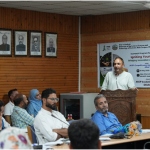Abdul Aziz Sofi is an aged resident from Lethpora village, one of the prominent saffron growing areas in Pulwama along Srinagar Jammu National Highway near historic town of Awantipora, who has been cultivating25 kanals of land with Saffron from past many years.
He is one among the progressive farmers of Kashmir who were first to get benefited by post harvest management and sale of saffron through India International Kashmir Saffron Trade Centre (IIKSTC), situated at Dusso area of saffron town Pampore in South Kashmir’s Pulwama district.
“Last year I sold around 306 grams of dry saffron through IIKSTC and fetched a rate which was double than the prevailing rate in the market at that time,” he said, adding that the market rate was around rupees 100 per gram during previous year when he fetched rupees 200 per gram through e -auction at IIKSTC.
This year he has deposited 840 grams of wet stigma at the facility for post harvest management and it’s subsequent sale.
Aziz told Rising Kashmir that the saffron growers from different areas of Kashmir held a meeting with officials of Agriculture Production and Farmer Welfare Kashmir at IIKSTC for fixing a base price.
“There was no census on the base price. We will be meeting with the officials again to reach a consensus,” he said, adding that their produce is listed for sale through e-bidding at a rate higher than the base price.
He informed that from past couple of years saffron growers are getting comparatively good rate for their produce which resulted that number of farmers from Lethpora taking benefit from IIKSTC rose from 5 percent to 70 percent from 2020 to 2022.
Aziz said that apart from providing post harvest management and e-auction services, introduction of IIKSTC has saved saffron growers from exploitation by middle agents and menace of adulteration by unscrupulous elements.
“Local agents buy saffron by tola and each tola weighs around 11.66 gram while at IIKSTC a tola is of 10 grams,” he said, adding that a grower is saved from a loss of 1.66 grams per tola.
He further said that he has witnessed many buyers felling prey to unscrupulous elements.“The naive customers were handed Iranian saffron for Kashmiri saffron,” he said, adding that the sellers earn 100 per cent profit through this murky trade as they get Iranian saffron at cheaper rate and sell it on high prices in the name of Kashmiri saffron.
Officials of agriculture production and farmer welfare department Kashmir informed Rising Kashmir that establishment of IIKSTC was one of the components of National Mission on Saffron which was launched in 2010-11.
They said that this project was established with rupees 37 crore and described it as a wonderful gift of central government for saffron growers of Kashmir.
The officials added that previously it was known as Spice Park and was renamed as IIKSTC in 2018 by Dr Areez then MD NHB ( National Horticulture Board ) along with then Director of Agriculture Production and Farmer Welfare Kashmir Syed Aijaz Andrabi.
They added that the facility started functioning on pilot basis in 2018 and since 2019 it has been functional round the clock.
IIKSTC Dusso consists of a processing building, anadministrative block, e- auction centre, conference hall, guest house and a power sub station.It has six main sections, each under a section head.
Fresh saffron flowers are received from farmers at the collection centre where the consignment is weighed along with recording name of the farmer and date of collection.
“The consignment is coded for confidentiality,” Dr Nayeem Wani, technical Manager Quality Evaluation Laboratory, IIKSTC said, adding that it is then sent to stigma separation unit where the consignment is again weighed.
“The farmer separates stigma from the flowers in ahall which can accommodate around 400 persons at a time,” he said, adding that protocols demand that all post harvest processing is to be done at IIKSTC to check any adulteration or misbranding.
He added that they have a cold storage facility where fresh flowers can be stored for up to 72 hours.
The separated wet stigmas are next moved to dryer section for vacuum drying.“There are four thermal dryers and each dryer has a capacity of drying 9 kilograms of wet stigma in 20 to 40 minutes,” Dr Nayeem said, adding that thermal drying traps all three important ingredients of stigma Crocin, Picrocrin and Safranal within it.
He said that these ingredients are volatile in natural and get evaporated by traditional practice of sun drying which affects quality and colouration of saffron.
Next, 10 grams of stigma from each consignment are sent to Quality Evaluation Laboratory which as per officials is accredited byNational Accreditation Board for Testing and Calibration Laboratories ( NABL).
Dr Nayeem said that saffron sells on the basis of grades which include G1, G2 and G3 depending up on strength of these three ingredients and other associated factors.
He said as per ISO ( International organization for Standardization) 3632, a test procedure, moisture content in stigma should not be more than 12.
“ The Crocin content should be around 200 percent for G1, 170 for G2 and 120 for G3,” he said, adding that Crocin determines colour strength of saffron.
Traditional practice of sun drying Crocin would get evaporated and which used to affect colouration of our saffron as compared to that of Iranian saffron, he elaborated.
“But from last two years we have been constantly getting a Crocin content of more than 270,” he said, adding this resulted all quantity of saffron processed at IIKSTC falls under G1.
Dr Nayeem said that during last year a G1 sample of saffron was sold for rupees 3 lakh a kilo at IIKSTC against rupees 1.55 lakh in the market.
“This is what establishment of IIKSTC achieved for saffron growers of Kashmir, it helped them to double their income,” Dr Nayeem said.
After testing the consignment is packed in sealed bottles.Next with prior notice to the grower it is listed for sale through e-auction portal.
Muzamil salmani, incharge auction centre, IIKSTC said that saffron growers can register as sellers at home and any one can register as buyer from any part of the country on the portal.
He said around 300 buyers from different parts of the country as well as from abroad are registered with them which include Tata Consumers, Lulu Group and Nuts Delish Pvt Ltd.Over past couple of years number of growers and buyers reporting at IIKSTC has increased.
The saffron processed at IIKSTC has a grade certification for quality and GI tag certification for origin as Kashmiri saffron.“We Create auctions and schedule them for bidding with prior notification to buyers,” Salmani said, adding that they have beenrunning the auction model successfully from last two years;it created stability in market and ended fluctuations.
It was informed that the produce is sold as per their serial number and payments are credited directly into their account within a week and all these services are provided free of cost to the farmers








